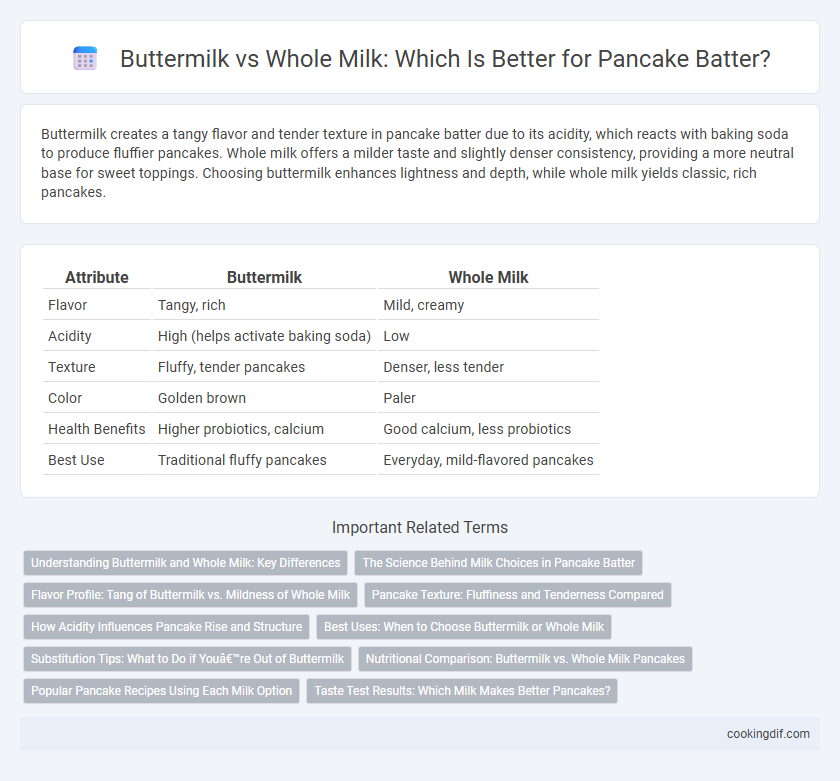Buttermilk creates a tangy flavor and tender texture in pancake batter due to its acidity, which reacts with baking soda to produce fluffier pancakes. Whole milk offers a milder taste and slightly denser consistency, providing a more neutral base for sweet toppings. Choosing buttermilk enhances lightness and depth, while whole milk yields classic, rich pancakes.
Table of Comparison
| Attribute | Buttermilk | Whole Milk |
|---|---|---|
| Flavor | Tangy, rich | Mild, creamy |
| Acidity | High (helps activate baking soda) | Low |
| Texture | Fluffy, tender pancakes | Denser, less tender |
| Color | Golden brown | Paler |
| Health Benefits | Higher probiotics, calcium | Good calcium, less probiotics |
| Best Use | Traditional fluffy pancakes | Everyday, mild-flavored pancakes |
Understanding Buttermilk and Whole Milk: Key Differences
Buttermilk contains higher acidity and lower fat content compared to whole milk, which creates a tender and fluffy texture in pancake batter through chemical reactions with baking soda. Whole milk provides a creamier texture and richer flavor but lacks the acidity that activates leavening agents, resulting in denser pancakes. Understanding these differences helps bakers choose the ideal milk type based on desired pancake texture and taste.
The Science Behind Milk Choices in Pancake Batter
Buttermilk contains lactic acid that reacts with baking soda in pancake batter to produce carbon dioxide, resulting in a lighter, fluffier texture compared to whole milk. Whole milk lacks this acidity, leading to denser pancakes unless additional acid is added. The choice between buttermilk and whole milk directly influences the batter's pH and the chemical leavening process, critical for achieving the desired pancake rise and tenderness.
Flavor Profile: Tang of Buttermilk vs. Mildness of Whole Milk
Buttermilk adds a distinct tangy flavor to pancake batter, enhancing the overall taste with a subtle acidity that complements the sweetness of the syrup. Whole milk contributes a mild and creamy profile, resulting in pancakes with a softer, more neutral flavor. The choice between buttermilk and whole milk significantly affects the pancake's flavor complexity and texture.
Pancake Texture: Fluffiness and Tenderness Compared
Buttermilk creates a tangier pancake batter that reacts with baking soda to produce increased carbon dioxide, resulting in fluffier pancakes with a lighter texture compared to whole milk. Whole milk, being less acidic, yields pancakes that tend to be denser and less tender due to reduced leavening action. The acidity and thickness of buttermilk contribute to enhanced moisture retention and tenderness in the finished pancakes.
How Acidity Influences Pancake Rise and Structure
Buttermilk's higher acidity reacts with baking soda in pancake batter, creating carbon dioxide bubbles that enhance rise and produce a fluffier texture compared to whole milk. The acid-base reaction also strengthens gluten formation, resulting in a tender yet structured crumb. Using whole milk, with its neutral pH, yields denser pancakes due to less leavening gas and weaker gluten development.
Best Uses: When to Choose Buttermilk or Whole Milk
Buttermilk enhances pancake batter by providing a tangy flavor and tender crumb, making it ideal for fluffy, rich pancakes best served for breakfast or brunch. Whole milk, with its neutral taste and creamy texture, works well for everyday pancakes where a classic, mild flavor is desired. Opt for buttermilk when seeking moisture and acidity to activate baking soda, and choose whole milk for a straightforward, versatile batter.
Substitution Tips: What to Do if You’re Out of Buttermilk
When out of buttermilk for pancake batter, substitute with whole milk plus 1 tablespoon of lemon juice or white vinegar per cup, allowing it to sit for 5-10 minutes to curdle and mimic buttermilk's acidity. This acidic reaction activates leavening agents like baking soda, ensuring fluffy, tender pancakes. Using plain whole milk without acidity may result in denser pancakes with less rise and softer texture.
Nutritional Comparison: Buttermilk vs. Whole Milk Pancakes
Buttermilk pancakes typically offer lower fat content and fewer calories than those made with whole milk, making them a slightly healthier option. Buttermilk contains beneficial probiotics and a higher acid content that enhances nutrient absorption and improves digestion. Whole milk provides more calcium and vitamin D, essential for bone health, but also contributes additional saturated fat to the pancake batter.
Popular Pancake Recipes Using Each Milk Option
Buttermilk is favored in popular pancake recipes like classic Southern pancakes and buttermilk blueberry pancakes due to its tangy flavor and tender texture, which reacts with baking soda to create fluffy stacks. Whole milk recipes, commonly seen in traditional American pancakes and fluffy buttermilk-free versions, provide a richer and slightly denser batter that yields a moist and soft pancake. Choosing buttermilk enhances flavor complexity and rise, while whole milk recipes emphasize a comforting, creamy consistency perfect for everyday pancakes.
Taste Test Results: Which Milk Makes Better Pancakes?
Buttermilk consistently produces fluffier pancakes with a tangy flavor and tender crumb due to its acidity reacting with baking soda, enhancing rise and texture. Whole milk yields a milder, creamier taste and slightly denser pancakes, making them rich but less airy. Taste test results show a clear preference for buttermilk pancakes, favored for their lightness and balanced flavor profile.
Buttermilk vs whole milk for pancake batter Infographic

 cookingdif.com
cookingdif.com